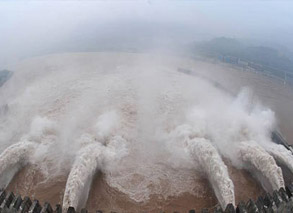New vision of future energy unveiled
2009-12-07 19:06 BJTSpecial Report: UN climate change conference in Copenhagen |
As the threat of climate change grows, being "green" is more fashionable than ever. But have you heard of blue energy? Dutch scientists are developing a project to create sustainable energy from water's different salt levels.
In the port of Rotterdam, fresh and salt water mix.
This has inspired scientists at the Dutch Center for Sustainable Water Technology -- Wetsus -- to develop a sustainable energy project named Blue Energy.
Their work is based on American scientist Sidney Loeb's theory that the process to extract drinking water from sea water can also produce electric power.
Scientist at Wetsus have created a simulator to test the theory.
Experiments prove that when fresh and salt water join, the concentration will diffuse until the salinity is equal throughout. When a selective membrane is placed between sweet and salt water, the diffusion can be controlled and potential energy created.
Joos Veerman, head of Wetsus Research Team, said, "Sea water contains two different kinds of small parts: Natrium ions and Chloride ions, positive and negative ions. And the ions have two types of membranes.
One type only lets the positive ions pass and the other membrane only the negative ions. Imagine in between my hands the sea water, the positive ions pass through this membrane and the negative ions pass through this membrane and we have an electric stream between the sea water and the fresh water that is on either side of the two membranes."
Scientists say that economically you can derive 1 mega watt of electrical power from 1 cubic fresh water meter per second. However, doubts linger.
Professor Reolof Schuiling, Utrecht University, said, "The principle was clear, but we were not sure about how we could derive actual energy from it. The system works well in the lab, but the question is how things would work in reality."
But if it does prove to be practical, Wetsus estimates Blue Energy technology could produce three-thousand megawatts in the Netherlands, covering almost one-third of the country's total annual energy consumption.

 Mail
Mail Share
Share Print
Print


 Video
Video









 2009 China Central Television. All Rights Reserved
2009 China Central Television. All Rights Reserved